Nonlinear Evolutionary Pattern Recognition of Land Subsidence in the Beijing Plain
Abstract
:1. Introduction
2. Study Area and Dataset
2.1. Study Area
2.2. Datasets
3. Methods
3.1. PS-InSAR Monitoring for Time-Series Deformation
3.2. Temporal Evolution Pattern Recognition
4. Results
4.1. PS-InSAR Results
4.2. Temporal Evolution Pattern Recognition
4.2.1. Cubic Polynomial Fitting of Nonlinear Time-Series Settling Curves
4.2.2. Recognition of Nonlinear Evolution Patterns of Ground Subsidence
5. Analysis of Influencing Factors
5.1. Relationship between Temporal Evolutionary Features and Groundwater
5.2. Relationship between Temporal Evolution Pattern and Geological Setting
5.3. Relationship between Temporal Evolution Pattern and Land Use
6. Conclusions
- (1)
- The spatial distribution of ground subsidence in the Beijing Plain area is clearly uneven, and the subsidence centers are located in the eastern, northeastern, and northern areas of the plain; the subsidence centers gradually grow larger and more connected. The maximum annual average subsidence rate from 2003 to 2020 reached 138.55 mm/year, in the Dongbalizhuang–Dajiaoting subsidence center in Chaoyang. Compared with linear, quadratic, and quartic polynomials, cubic polynomials can better characterize the nonlinear evolution of ground subsidence over a long time-series. Comparing the fitted subsidence with the PS-InSAR results, the R2 was greater than 0.86, the RMSE was less than 60.28 mm, and the accuracy met the requirements of the study.
- (2)
- In the subsidence zone, 86.58% of the PS point subsidence rates began to decrease in 2010–2015, 30.51% of the PS point subsidence reached a maximum in 2015–2019 and then decreased, and 69.49% continued to increase. The evolutionary pattern of the subsidence zone was dominated by two evolutionary features: the subsidence rate first increased and then decreased, and the amount of subsidence continued to increase (evolution pattern D (Vs+-, S+)); the rate of subsidence first increased and then decreased, and the amount of subsidence increased and then decreased (evolution pattern B (Vs+-, S+-)). In 2010–2015, the rate of subsidence began to decrease in most areas, and ground subsidence disasters were somewhat alleviated. In the central part of the subsidence zone and fringe area of Tongzhou, the subsidence rate and amount of subsidence continued to increase, and ground subsidence disasters intensified. With the rapid development of the Chaoyang and Tongzhou subsidence areas, attention should be paid to subsidence prevention and control.
- (3)
- Considering the relationship between groundwater level, geological background, land use and the evolutionary pattern of ground subsidence, in areas where the subsidence belongs to evolution pattern D (Vs+-, S+), a high correlation exists between the groundwater level and time-series evolutionary characteristics of ground subsidence; the correlation between the ground subsidence and the water table reaches 0.89, and the period of the decrease in the subsidence rate similar to that of the groundwater level rebounds. In areas where the thickness of the compressible clay layer is greater than 210 m, the ground subsidence belongs to evolution pattern E (Vs+, S+), and the subsidence rate and amount continue to increase. The thicker compressible clay provides favorable conditions for the rapid development of ground subsidence. On both sides of the Gaoliying and Sunhe fractures, settlement evolutionary patterns have clear differences, and the fracture has a certain controlling effect on the spatial pattern of settlement evolution. The settlement near the terminal station of Line 7, the Global Resort Station, displays evolution pattern E (Vs+, S+) and the rate of settlement is increasing; the changes in land use, construction precipitation, etc., may be the factors that lead to the rapid development of ground subsidence in this area.
Author Contributions
Funding
Data Availability Statement
Acknowledgments
Conflicts of Interest
References
- Hasan, M.F.; Smith, R.; Vajedian, S.; Pommerenke, R.; Majumdar, S. Global land subsidence mapping reveals widespread loss of aquifer storage capacity. Nat. Commun. 2023, 14, 6180. [Google Scholar] [CrossRef] [PubMed]
- Herrera-Garcia, G.; Ezquerro, P.; Tomas, R.; Bejar-Pizarro, M.; Lopez-Vinielles, J.; Rossi, M.; Mateos, R.M.; Carreon-Freyre, D.; Lambert, J.; Teatini, P.; et al. Mapping the global threat of land subsidence. Science 2021, 371, 34–36. [Google Scholar] [CrossRef] [PubMed]
- Gong, H.; Pan, Y.; Zheng, L.; Li, X.; Zhu, L.; Zhang, C.; Huang, Z.; Li, Z.; Wang, H.; Zhou, C.; et al. Long-term groundwater storage changes and land subsidence development in the North China Plain (1971–2015). Hydrogeol. J. 2018, 26, 1417–1427. [Google Scholar] [CrossRef]
- Tzampoglou, P.; Ilia, I.; Karalis, K.; Tsangaratos, P.; Zhao, X.; Chen, W. Selected Worldwide Cases of Land Subsidence Due to Groundwater Withdrawal. Water 2023, 15, 1094. [Google Scholar] [CrossRef]
- Ye, S.; Xue, Y.; Wu, J.; Yan, X.; Yu, J.; Galloway, D.L.; Kuniansky, E.L.; Rowland, J.C. Progression and mitigation of land subsidence in China. Hydrogeol. J. 2016, 24, 685–693. [Google Scholar] [CrossRef]
- Ao, Z.; Hu, X.; Tao, S.; Hu, X.; Wang, G.; Li, M.; Wang, F.; Hu, L.; Liang, X.; Xiao, J.; et al. A national-scale assessment of land subsidence in China’s major cities. Science 2024, 384, 301–306. [Google Scholar] [CrossRef] [PubMed]
- Sato, H.P.; Abe, K.; Ootaki, O. GPS-measured land subsidence in Ojiya City, Niigata Prefecture, Japan. Eng. Geol. 2003, 67, 379–390. [Google Scholar] [CrossRef]
- Aimaiti, Y.; Yamazaki, F.; Liu, W. Multi-Sensor InSAR Analysis of Progressive Land Subsidence over the Coastal City of Urayasu, Japan. Remote Sens. 2018, 10, 1304. [Google Scholar] [CrossRef]
- Chaussard, E.; Wdowinski, S.; Cabral-Cano, E.; Amelung, F. Land subsidence in central Mexico detected by ALOS InSAR time-series. Remote Sens. Environ. 2014, 140, 94–106. [Google Scholar] [CrossRef]
- Cigna, F.; Tapete, D. Present-day land subsidence rates, surface faulting hazard and risk in Mexico City with 2014–2020 Sentinel-1 IW InSAR. Remote Sens. Environ. 2021, 253, 112161. [Google Scholar] [CrossRef]
- Faunt, C.C.; Sneed, M.; Traum, J.; Brandt, J.T.; Galloway, D.L.; Kuniansky, E.L.; Rowland, J.C. Water availability and land subsidence in the Central Valley, California, USA. Hydrogeol. J. 2016, 24, 675–684. [Google Scholar] [CrossRef]
- Sun, H.; Grandstaff, D.; Shagam, R. Land subsidence due to groundwater withdrawal; potential damage of subsidence and sea level rise in southern New Jersey, USA. Environ. Geol. 1999, 37, 290–296. [Google Scholar] [CrossRef]
- Kumar, H.; Syed, T.H.; Amelung, F.; Agrawal, R.; Venkatesh, A.S. Space-time evolution of land subsidence in the National Capital Region of India using ALOS-1 and Sentinel-1 SAR data: Evidence for groundwater overexploitation. J. Hydrol. 2022, 605, 127329. [Google Scholar] [CrossRef]
- Riyas, M.; Syed, T.; Kumar, H.; Kuenzer, C. Detecting and analyzing the evolution of subsidence due to coal fires in Jharia Coalfield, India using Sentinel-1 SAR data. Remote Sens. 2021, 13, 1521. [Google Scholar] [CrossRef]
- Gao, M.; Gong, H.; Li, X.; Chen, B.; Zhou, C.; Shi, M.; Guo, L.; Chen, Z.; Ni, Z.; Duan, G. Land Subsidence and Ground Fissures in Beijing Capital International Airport (BCIA): Evidence from Quasi-PS InSAR Analysis. Remote Sens. 2019, 11, 1466. [Google Scholar] [CrossRef]
- Lei, K.; Luo, Y.; Chen, B.; Guo, G.; Zhou, Y. Distribution characteristics and influence factors of land subsidence in Beijing area. Geol. China 2016, 43, 2216–2225. [Google Scholar]
- Zhu, X.; Zhu, W.; Guo, L.; Yinghai, K.; Li, X.; Zhu, L.; Sun, Y.; Liu, Y.; Chen, B.; Tian, J.; et al. Study on Land Subsidence Simulation Based on a Back-Propagation Neural Network Combined with the Sparrow Search Algorithm. Remote Sens. 2023, 15, 2978. [Google Scholar] [CrossRef]
- Galloway, D.L.; Burbey, T.J. Review: Regional land subsidence accompanying groundwater extraction. Hydrogeol. J. 2011, 19, 1459–1486. [Google Scholar] [CrossRef]
- Poland, M.; Burgmann, R.; Dzurisin, D.; Lisowski, M.; Masterlark, T.; Owen, S.E.; Fink, J.; Poland, M.; Newman, A. Constraints on the mechanism of long-term, steady subsidence at Medicine Lake Volcano, Northern California, from GPS, leveling, and InSAR. J. Volcanol. Geoth. Res. 2006, 150, 55–78. [Google Scholar] [CrossRef]
- Osmanoglu, B.; Dixon, T.H.; Wdowinski, S.; Cabral-Cano, E.; Jiang, Y. Mexico City subsidence observed with Persistent Scatterer InSAR. Int. J. Appl. Earth Obs. 2011, 13, 1–12. [Google Scholar] [CrossRef]
- Liu, Y.; Zhang, Y.; Zhao, F.; Ding, R.; Zhao, L.; Niu, Y.; Qu, F.; Ling, Z. Multi-Source SAR-Based Surface Deformation Monitoring and Groundwater Relationship Analysis in the Yellow River Delta, China. Remote Sens. 2023, 15, 3290. [Google Scholar] [CrossRef]
- Zheng, Y.; Peng, J.; Li, C.; Chen, X.; Peng, Y.; Ma, X.; Huang, M. Long-Term SAR Data Analysis for Subsidence Monitoring and Correlation Study at Beijing Capital Airport. Remote Sens. 2024, 16, 445. [Google Scholar] [CrossRef]
- Ng, A.H.; Ge, L.; Li, X.; Zhang, K. Monitoring ground deformation in Beijing, China with persistent scatterer SAR interferometry. J. Geod. 2012, 86, 375–392. [Google Scholar] [CrossRef]
- Ferretti, A.; Prati, C.; Rocca, F. Nonlinear subsidence rate estimation using permanent scatterers in differential SAR interferometry. IEEE Trans. Geosci. Remote Sens. 2000, 38, 2202–2212. [Google Scholar] [CrossRef]
- Ferretti, A.; Prati, C.; Rocca, F. Permanent scatterers in SAR interferometry. IEEE Trans. Geosci. Remote Sens. 2001, 39, 8–20. [Google Scholar] [CrossRef]
- Jiang, H.; Balz, T.; Li, J. Land Subsidence in Wuhan Revealed Using a Multi-Sensor InSAR Time Series Fusion Approach. Int. Arch. Photogramm. Remote Sens. Spat. Inf. Sci. 2023, 48, 1399–1404. [Google Scholar] [CrossRef]
- Lyu, M.; Li, X.; Ke, Y.; Jiang, J.; Zhu, L.; Guo, L.; Gong, H.; Chen, B.; Xu, Z.; Zhang, K.; et al. Reconstruction of spatially continuous time-series land subsidence based on PS-InSAR and improved MLS-SVR in Beijing Plain area. GISci. Remote Sens. 2023, 60, 2230689. [Google Scholar] [CrossRef]
- Zuo, J.; Gong, H.; Chen, B.; Liu, K.; Zhou, C.; Ke, Y. Time-series evolution patterns of land subsidence in the eastern Beijing plain, China. Remote Sens. 2019, 11, 539. [Google Scholar] [CrossRef]
- Ikuemonisan, F.E.; Ozebo, V.C.; Olatinsu, O.B. Investigation of Sentinel-1-derived land subsidence using wavelet tools and triple exponential smoothing algorithm in Lagos, Nigeria. Environ. Earth Sci. 2021, 80, 722. [Google Scholar] [CrossRef]
- Lyu, M.; Ke, Y.; Li, X.; Zhu, L.; Guo, L.; Gong, H. Detection of Seasonal Deformation of Highway Overpasses Using the PS-InSAR Technique: A Case Study in Beijing Urban Area. Remote Sens. 2020, 12, 3071. [Google Scholar] [CrossRef]
- Zhu, L.; Gong, H.; Li, X.; Wang, R.; Chen, B.; Zhenxue, D.; Pietro, T. Land subsidence due to groundwater withdrawal in the northern Beijing Plain, China. Eng. Geol. 2015, 193, 243–255. [Google Scholar] [CrossRef]
- Shi, M.; Chen, B.; Gong, H.; Li, X.; Chen, W.; Gao, M.; Zhou, C.; Lei, K. Monitoring Differential Subsidence along the Beijing-Tianjin Intercity Railway with Multiband SAR Data. Int. J. Environ. Res. Public Health 2019, 16, 4453. [Google Scholar] [CrossRef] [PubMed]
- Chen, B.; Gong, H.; Chen, Y.; Lei, K.; Zhou, C.; Si, Y.; Li, X.; Pan, Y.; Gao, M. Investigating land subsidence and its causes along Beijing high-speed railway using multi-platform InSAR and a maximum entropy model. Int. J. Appl. Earth Obs. 2021, 96, 102284. [Google Scholar] [CrossRef]
- Li, M.; Ge, D.; Zhang, L.; Guo, X.; Liu, B.; Wang, Y.; Wu, Q. Assessment of the temporal-spatial evolution of subsidence and its driving mechanism in the Beijing Plain (China) by using SAR interferometry and geological data. Geomat. Nat. Hazards Risk 2021, 12, 2708–2735. [Google Scholar] [CrossRef]
- Park, S.; Hong, S. Nonlinear modeling of subsidence from a decade of InSAR time series. Geophys. Res. Lett. 2021, 48, e2020GL090970. [Google Scholar] [CrossRef]
- Chen, M.; Tomas, R.; Li, Z.; Motagh, M.; Li, T.; Hu, L.; Huili, G.; Xiaojuan, L.; Jun, Y.; Xulong, G. Imaging land subsidence induced by groundwater extraction in Beijing (China) using satellite radar interferometry. Remote Sens. 2016, 8, 468. [Google Scholar] [CrossRef]
- Li, Y.; Gong, H.; Zhu, L.; Li, X. Measuring Spatiotemporal Features of Land Subsidence, Groundwater Drawdown, and Compressible Layer Thickness in Beijing Plain, China. Water 2017, 9, 64. [Google Scholar] [CrossRef]
- Chen, B.; Gong, H.; Chen, Y.; Li, X.; Zhou, C.; Lei, K.; Zhu, L.; Duan, L.; Zhao, X. Land subsidence and its relation with groundwater aquifers in Beijing. Sci. Total Environ. 2020, 735, 139111. [Google Scholar] [CrossRef] [PubMed]
- Zheng, Y.; Peng, J.; Chen, X.; Huang, C.; Chen, P.; Li, S.; Su, Y. Spatial and Temporal Evolution of Ground Subsidence in the Beijing Plain Area Using Long Time Series Interferometry. IEEE Trans. Geosci. Remote Sens. 2023, 16, 153–165. [Google Scholar] [CrossRef]
- Du, Z.; Ge, L.; Ng, A.H.; Garthwaite, M.C.; Zhu, Q.; Horgan, F.G.; Zhang, Q. Analysis of the impact of the South-to-North Water Diversion Project on water balance and land subsidence in Beijing, China between 2007 and 2020. J. Hydrol. 2021, 603, 126990. [Google Scholar] [CrossRef]
- Lyu, M.; Ke, Y.; Guo, L.; Li, X.; Zhu, L.; Gong, H.; Constantinos, C. Change in regional land subsidence in Beijing after south-to-north water diversion project observed using satellite radar interferometry. GISci. Remote Sens. 2020, 57, 140–156. [Google Scholar] [CrossRef]
- Bahrami, M.; Mahmoudi, M.R. Long-term temporal trend analysis of climatic parameters using polynomial regression analysis over the Fasa Plain, southern Iran. Meteorol. Atmos. Phys. 2022, 134, 42. [Google Scholar] [CrossRef]
- Jamali, S.; Seaquist, J.; Eklundh, L.; Ardö, J. Automated mapping of vegetation trends with polynomials using NDVI imagery over the Sahel. Remote Sens. Environ. 2014, 141, 79–89. [Google Scholar] [CrossRef]
- Wilson, A.G. Covariance Kernels for Fast Automatic Pattern Discovery and Extrapolation with Gaussian Processes. Ph.D. Thesis, University of Cambridge, Cambridge, UK, 2014. [Google Scholar]
- Jiao, S.; Li, X.; Yu, J.; Lyu, M.; Zhang, K.; Li, Y.; Shi, P. Multi-Scale Analysis of Surface Building Density and Land Subsidence Using a Combination of Wavelet Transform and Spatial Autocorrelation in the Plains of Beijing. Sustainability 2024, 16, 2801. [Google Scholar] [CrossRef]
- Guo, L.; Gong, H.; Zhu, F.; Zhu, L.; Zhang, Z.; Zhou, C.; Gao, M.; Sun, Y. Analysis of the spatiotemporal variation in land subsidence on the Beijing Plain, China. Remote Sens. 2019, 11, 1170. [Google Scholar] [CrossRef]
- Zhang, Y.; Gong, H.; Gu, Z.; Wang, R.; Li, X.; Zhao, W. Characterization of land subsidence induced by groundwater withdrawals in the plain of Beijing City, China. Hydrogeol. J. 2014, 22, 397–409. [Google Scholar] [CrossRef]
- Chen, B.; Gong, H.; Li, X.; Lei, K.; Zhu, L.; Gao, M.; Zhou, C. Characterization and causes of land subsidence in Beijing, China. Int. J. Remote Sens. 2017, 38, 808–826. [Google Scholar] [CrossRef]
- Gao, M.; Gong, H.; Chen, B.; Li, X.; Zhou, C.; Shi, M.; Si, Y.; Chen, Z.; Duan, G. Regional Land Subsidence Analysis in Eastern Beijing Plain by InSAR Time Series and Wavelet Transforms. Remote Sens. 2018, 10, 365. [Google Scholar] [CrossRef]
- Chen, B.; Gong, H.; Lei, K.; Li, J.; Zhou, C.; Gao, M.; Guan, H.; Lv, W. Land subsidence lagging quantification in the main exploration aquifer layers in Beijing plain, China. Int. J. Appl. Earth Obs. 2019, 75, 54–67. [Google Scholar] [CrossRef]
- Shi, M.; Gao, M.; Chen, Z.; Lyu, M.; Gong, H.; Zhai, Y.; Pan, Y. Land subsidence in Beijing: Response to the joint influence of the South-to-North Water Diversion Project and ecological water replenishment, observed by satellite radar interferometry. GISci. Remote Sens. 2024, 61, 2315708. [Google Scholar] [CrossRef]
- Zheng, L.; Zhang, Y.; Ruitao, J.; Pengbo, Z. GMS-based numerical simulation and prediction analysis of groundwater environment in Chaoyang District of Beijing. Water Resour. Hydropower Eng. 2022, 53, 124–134. [Google Scholar]
- Wu, Y.; Xu, J.; Qiu, W.; Wang, M.; Li, S.; Shi, Y.; Wei, J. Study on ecological water replenishment scheduling scheme of Chaobai River in Beijing section. Water Resour. Hydropower Eng. 2023, 54, 180–189. [Google Scholar]
- Long, D.; Yang, W.; Scanlon, B.R.; Zhao, J.; Liu, D.; Burek, P.; Pan, Y.; You, L.; Wada, Y. South-to-North Water Diversion stabilizing Beijing’s groundwater levels. Nat. Commun. 2020, 11, 3665. [Google Scholar] [CrossRef]
- Guo, L.; Gong, H.; Ke, Y.; Zhu, L.; Li, X.; Lyu, M.; Zhang, K. Mechanism of land subsidence mutation in Beijing Plain under the background of urban expansion. Remote Sens. 2021, 13, 3086. [Google Scholar] [CrossRef]
- Du, D.; Liu, H.; Zhou, J.; Zhang, J.; Miao, J.; Li, Y.; Cao, X.; Ye, M. Study of the characteristics and influencing factors of land subsidence in the Tongzhou District of Beijing. Acta Geol. Sin. 2022, 96, 712–725. [Google Scholar]
- Zhang, G.; Weng, N.; Wang, L.; Zhang, Q.; Jiao, Z. Analysis on variation characteristics of groundwater level in Changping District. Beijing Water 2021, 25–29. [Google Scholar] [CrossRef]
- Mesri, B.G.; ASCE, M.; Choi, Y.K.; ASCE, A.M. Settlement Analysis of Embankments on Soft Clays. J. Geotech. Eng. 1985, 111, 441–464. [Google Scholar] [CrossRef]
- Zhang, L.; Bai, L.; Zhao, Y.; Zhang, X.; Yang, T.; Cai, X.; He, F. The difference of deposition rate in the boreholes at the junction between Nankou-Sunhe fault and Huangzhuang-Gaoliying fault and its response to fault activity in the Beijing area. Seismol. Geol. 2017, 39, 1048–1065. [Google Scholar]
- Wu, W.; Yun, Y.; Sun, Y.; Zhang, G. Tunnelling and Underground Space Technology incorporating Trenchless Technology Research. Tunn. Undergr. Sp. Tech. 2023, 133, 104941. [Google Scholar] [CrossRef]
- Shi, J.; Wu, B.; Liu, Y.; Xu, S.; Hou, J.; Wang, Y.; Sun, Q.; Meng, G.; Nong, Z.; Qiu, H.; et al. Analysis of the influence of groundwater seepage on the deformation of deep foundation pit with suspended impervious curtain. Adv. Mech. Eng. 2022, 14, 1992379939. [Google Scholar] [CrossRef]
- Xue, T.; Xue, X.; Long, S.; Chen, Q.; Lu, S.; Zeng, C. Effect of Pre-Existing Underground Structures on Groundwater Flow and Strata Movement Induced by Dewatering and Excavation. Water 2023, 15, 814. [Google Scholar] [CrossRef]
- Cao, J.; Gong, H.; Chen, B.; Shi, M.; Zhou, C.; Lei, K.; Yu, H.; Sun, Y. Land Subsidence in Beijing’s Sub-Administrative Center and Its Relationship with Urban Expansion Inferred from Sentinel-1/2. Can. J. Remote Sens. 2021, 47, 802–817. [Google Scholar] [CrossRef]

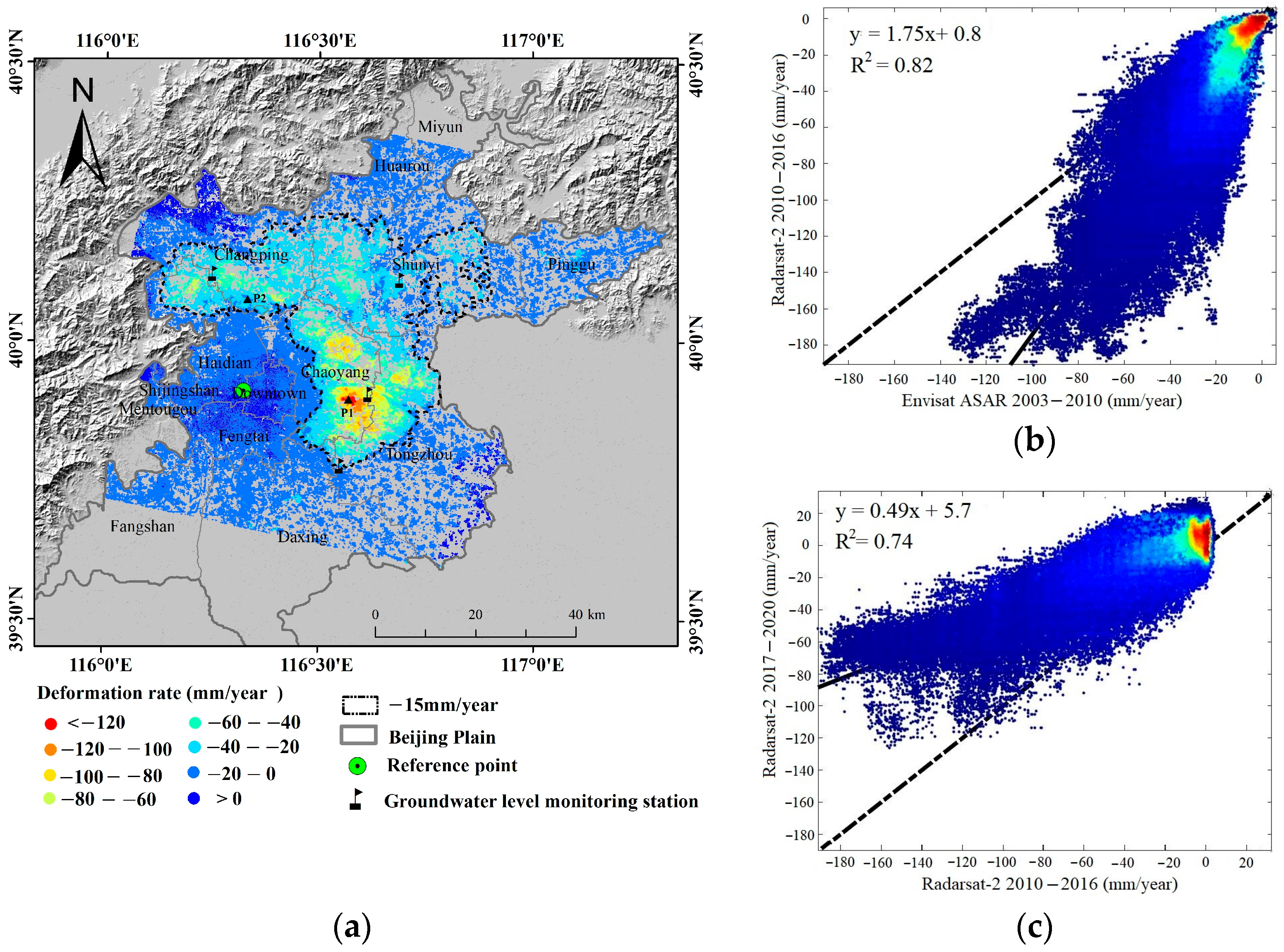
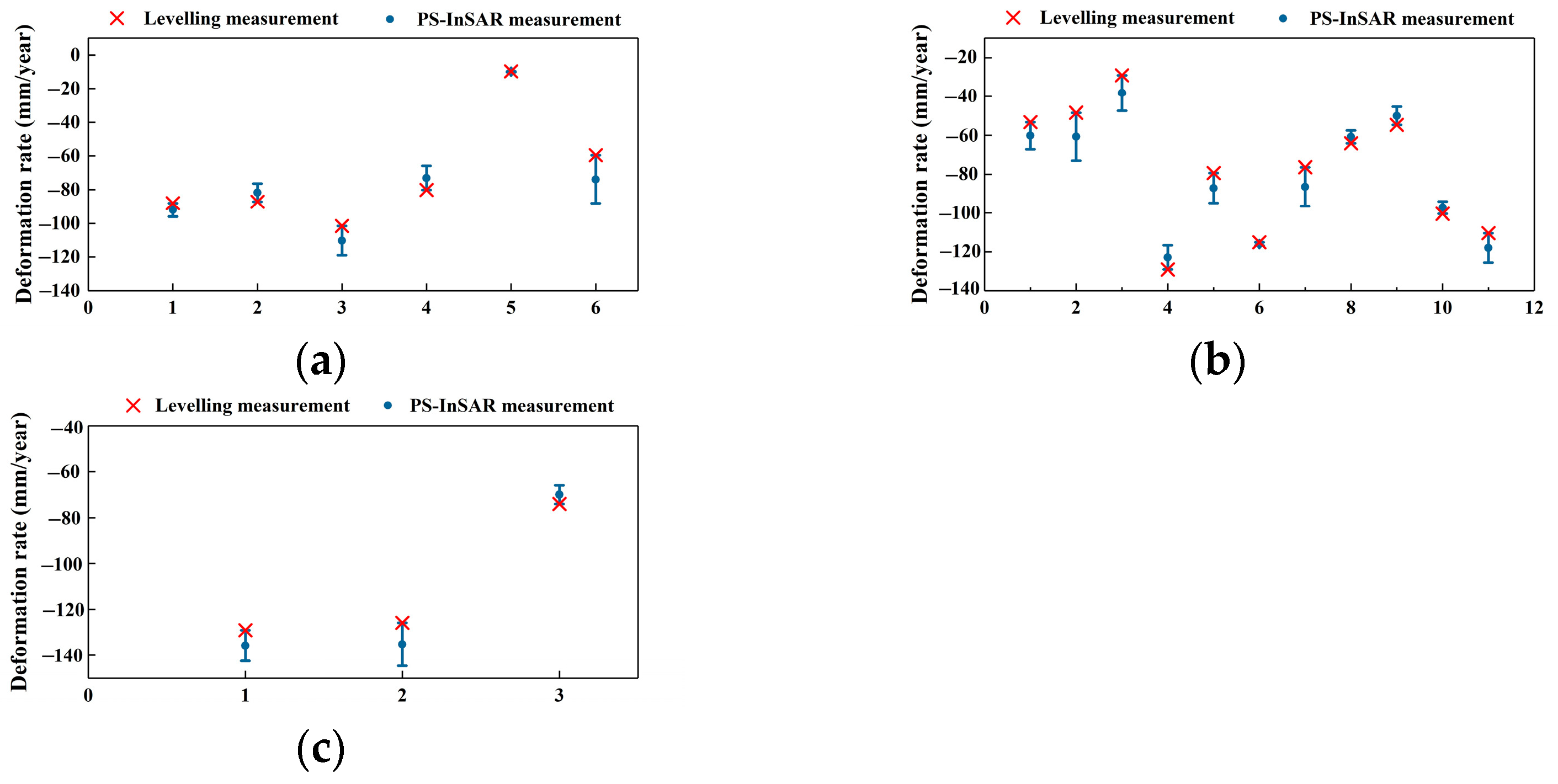
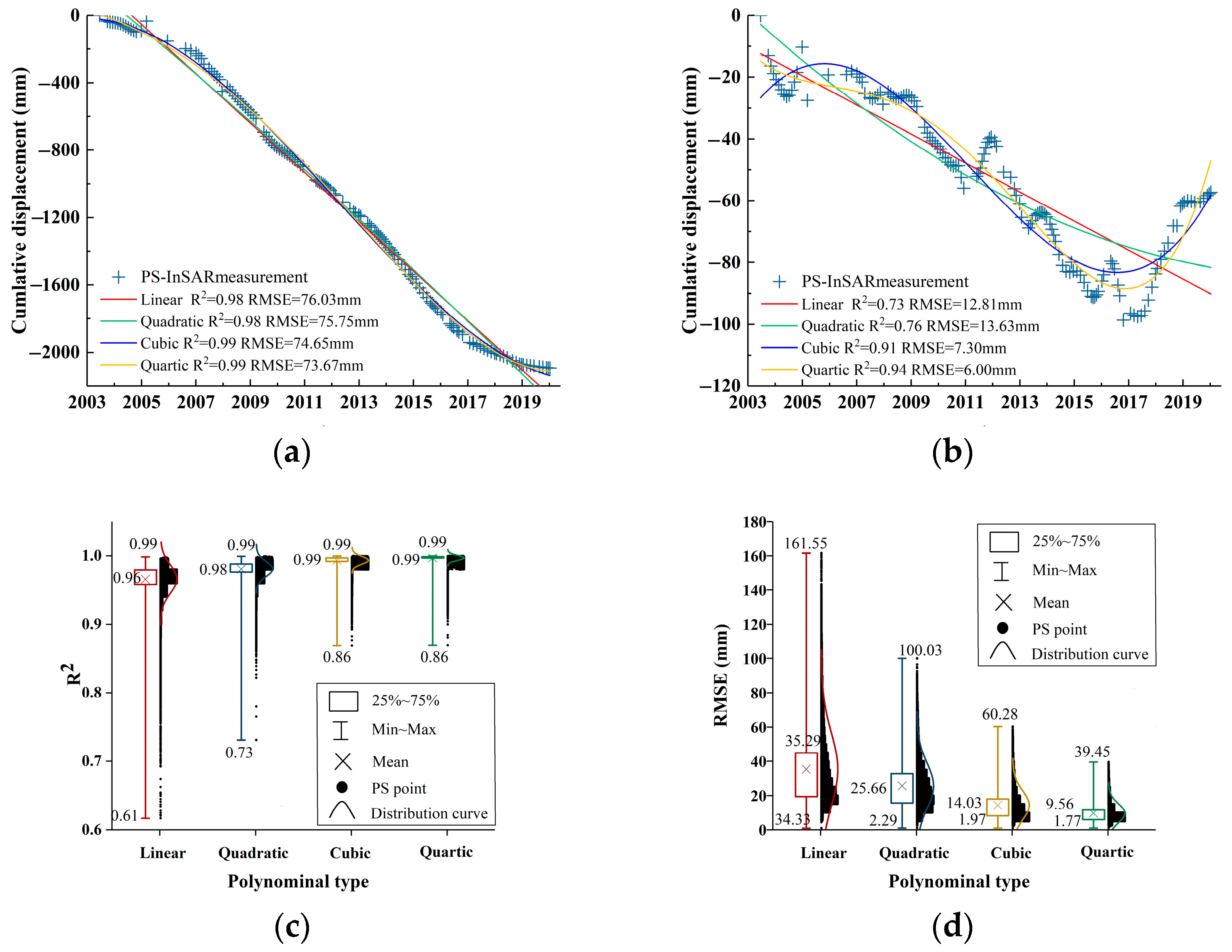
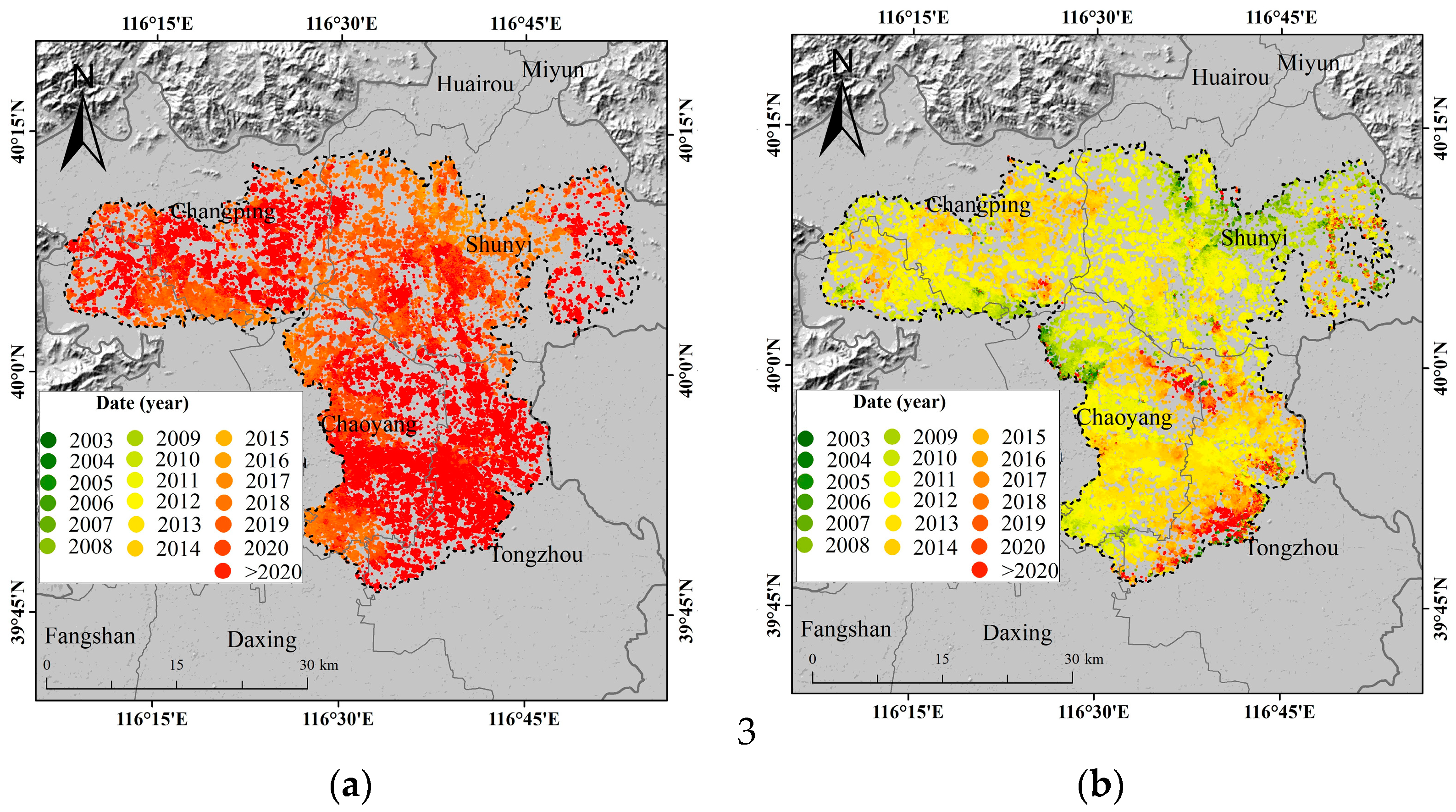
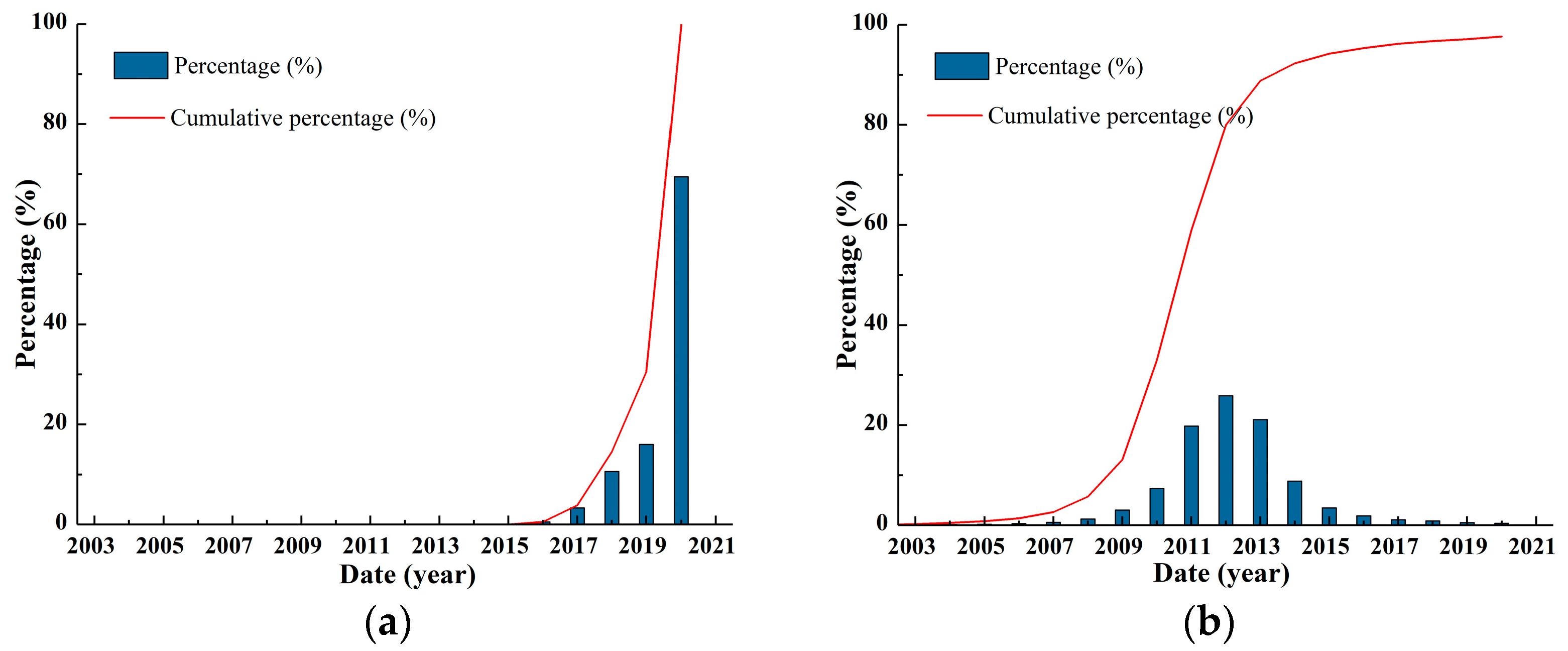
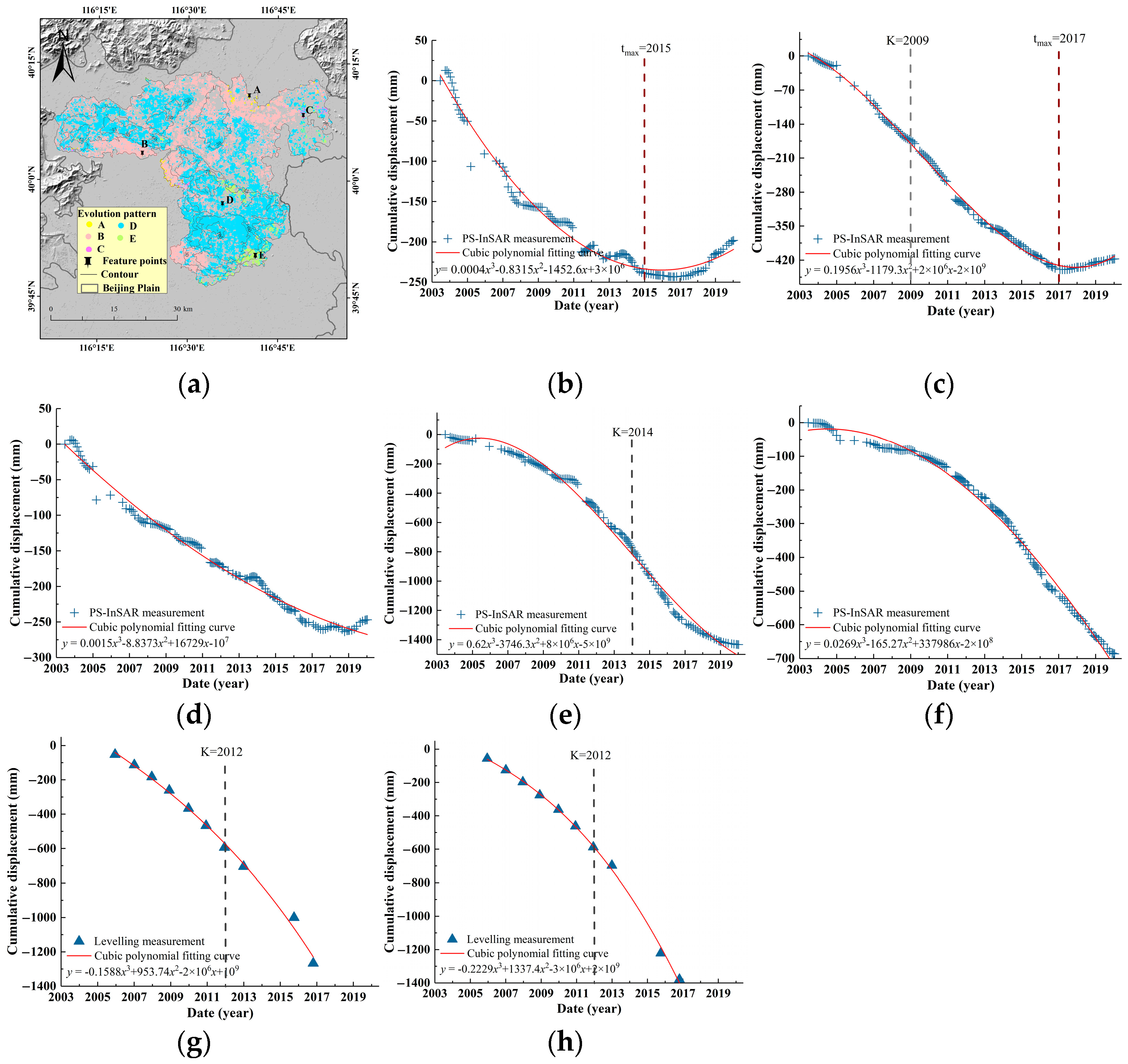

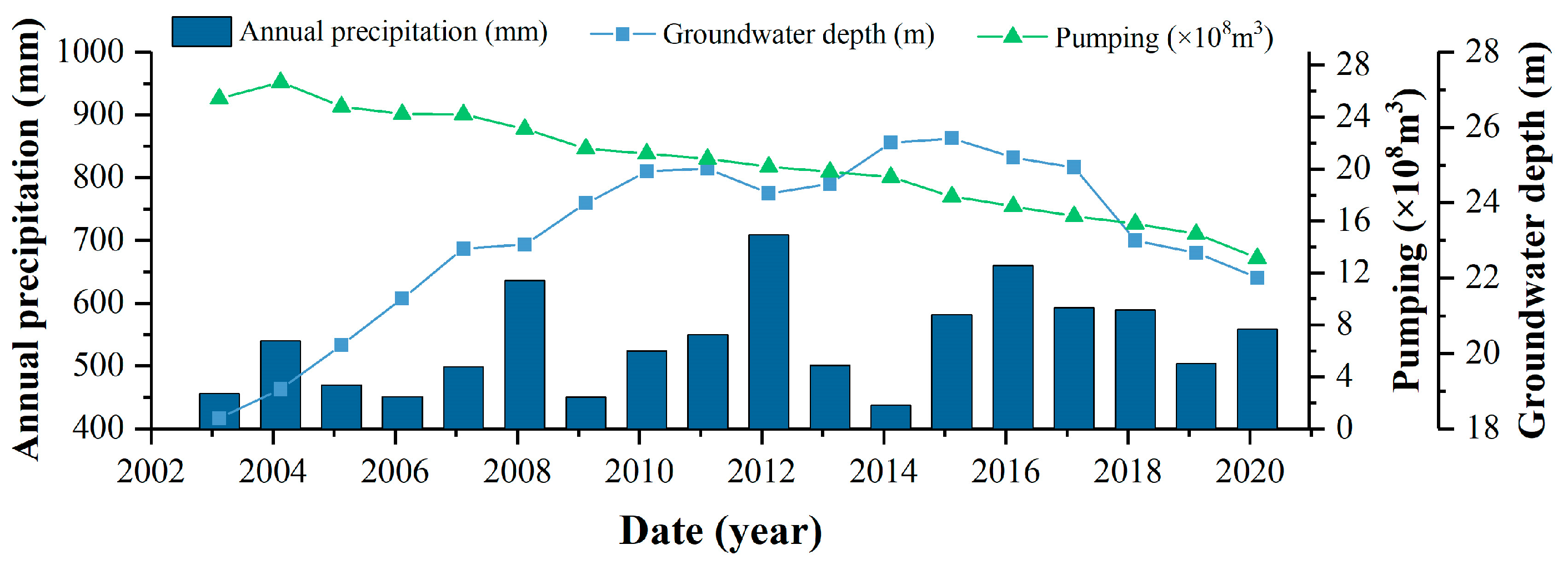

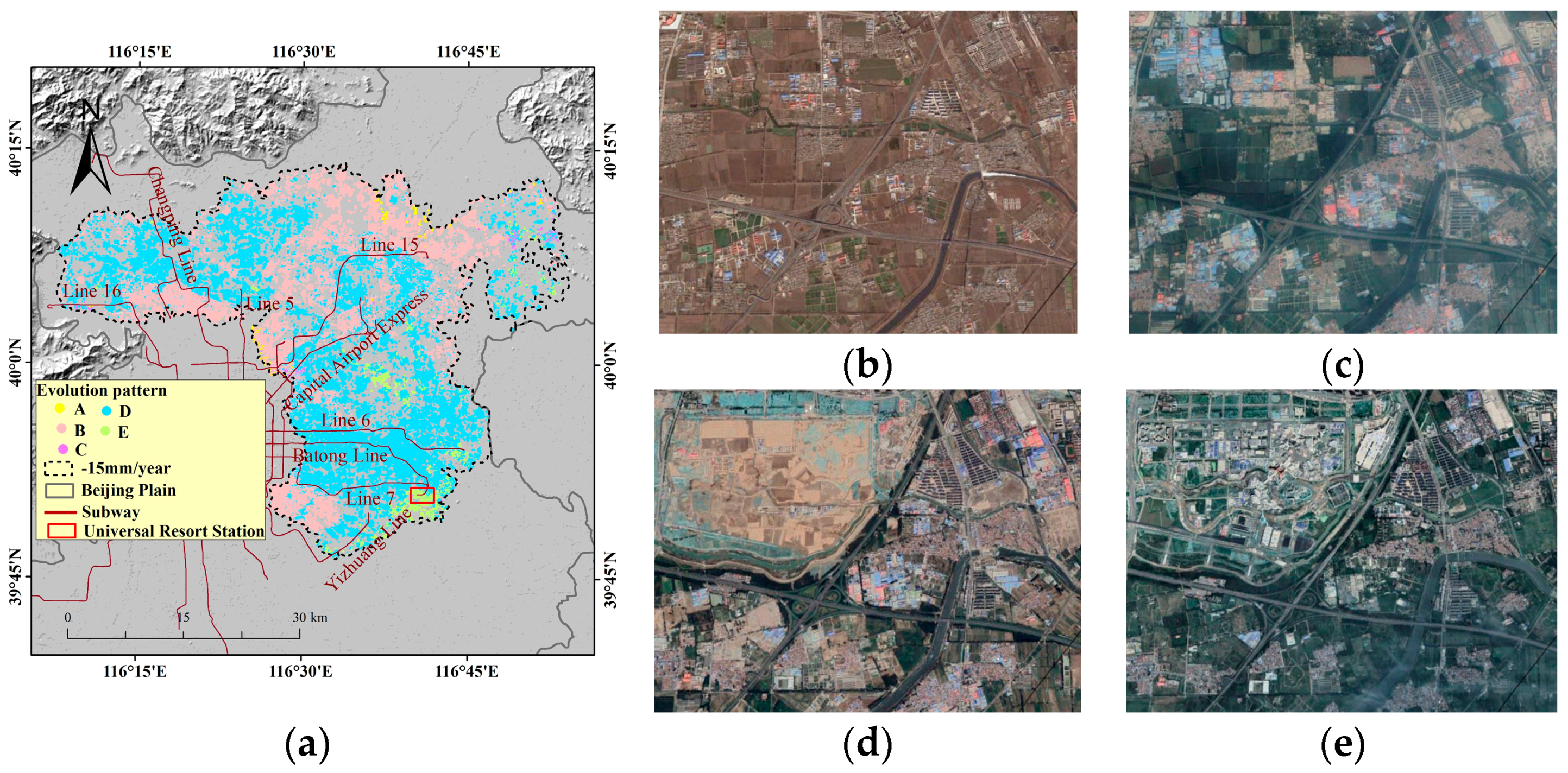
| SAR Sensor | Envisat ASAR | Radarsat-2 | Radarsat-2 |
|---|---|---|---|
| Orbit direction | Descending | Descending | Descending |
| Polarization | VV | VV | VV |
| Band | C | C | C |
| Wavelength (cm) | 5.6 | 5.6 | 5.6 |
| Incidence Angle | 22.8 | 33.9 | 22.56 |
| Image mode | Image | Standard | Extra-Fine |
| No. images | 55 | 37 | 43 |
| Date range | 18 June 2003–19 September 2010 | 22 November 2010–21 October 2016 | 25 January 2017–10 January 2020 |
| Evolution Pattern | Recognition Rule | Characteristic |
|---|---|---|
| A (−, S+-) | K ≤ 2003, < 2020 | The settlement rate continues to decrease, and the cumulative settlement first increases and then decreases |
| B (+-, S+-) | 2003 < K < 2020, < 2020 | The settlement rate first increases and then decreases, and the cumulative settlement first increases and then decreases |
| C (−, S+) | K ≤ 2003, ≥ 2020 | The settlement rate continues to decrease, and the cumulative settlement continues to increase |
| D (+-, S+) | 2003 < K < 2020, ≥ 2020 | The settlement rate first increases and then decreases, and the cumulative settlement continues to increase |
| E (+, S+) | K ≥ 2020, ≥ 2020 | The settlement rate continues to increase, and the cumulative settlement continues to increase |
Disclaimer/Publisher’s Note: The statements, opinions and data contained in all publications are solely those of the individual author(s) and contributor(s) and not of MDPI and/or the editor(s). MDPI and/or the editor(s) disclaim responsibility for any injury to people or property resulting from any ideas, methods, instructions or products referred to in the content. |
© 2024 by the authors. Licensee MDPI, Basel, Switzerland. This article is an open access article distributed under the terms and conditions of the Creative Commons Attribution (CC BY) license (https://creativecommons.org/licenses/by/4.0/).
Share and Cite
Lyu, M.; Li, X.; Ke, Y.; Jiang, J.; Sun, Z.; Zhu, L.; Guo, L.; Xu, Z.; Tang, P.; Gong, H.; et al. Nonlinear Evolutionary Pattern Recognition of Land Subsidence in the Beijing Plain. Remote Sens. 2024, 16, 2829. https://doi.org/10.3390/rs16152829
Lyu M, Li X, Ke Y, Jiang J, Sun Z, Zhu L, Guo L, Xu Z, Tang P, Gong H, et al. Nonlinear Evolutionary Pattern Recognition of Land Subsidence in the Beijing Plain. Remote Sensing. 2024; 16(15):2829. https://doi.org/10.3390/rs16152829
Chicago/Turabian StyleLyu, Mingyuan, Xiaojuan Li, Yinghai Ke, Jiyi Jiang, Zhenjun Sun, Lin Zhu, Lin Guo, Zhihe Xu, Panke Tang, Huili Gong, and et al. 2024. "Nonlinear Evolutionary Pattern Recognition of Land Subsidence in the Beijing Plain" Remote Sensing 16, no. 15: 2829. https://doi.org/10.3390/rs16152829






